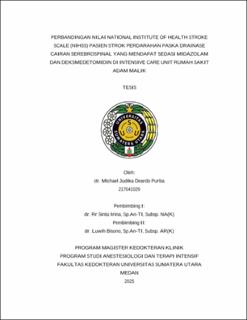| dc.contributor.advisor | Irina, Rr Sinta | |
| dc.contributor.advisor | Bisono, Luwih | |
| dc.contributor.author | Purba, Michael Judika Deardo | |
| dc.date.accessioned | 2025-07-17T05:44:45Z | |
| dc.date.available | 2025-07-17T05:44:45Z | |
| dc.date.issued | 2025 | |
| dc.identifier.uri | https://repositori.usu.ac.id/handle/123456789/105681 | |
| dc.description.abstract | Background: Stroke is a leading cause of morbidity and mortality worldwide. The National Institutes of Health Stroke Scale (NIHSS) is used to assess the neurological status of stroke patients. Cerebrospinal fluid (CSF) drainage is a critical intervention used to reduce intracranial pressure, and the choice of sedation and analgesia is crucial in ICU care. Midazolam provides sedative, anxiolytic, and anterograde amnesic effects, while dexmedetomidine has analgesic and anxiolytic properties with minimal effects on hemodynamics. Objective: To compare the NIHSS scores in hemorrhagic stroke patients after CSF drainage who received midazolam and dexmedetomidine sedation in the Intensive Care Unit of Adam Malik Hospital. Methods: This was a single-blind, randomized, controlled trial (RCT) that compared the NIHSS scores in hemorrhagic stroke patients after CSF drainage who received midazolam and dexmedetomidine sedation in the Intensive Care Unit of Adam Malik Hospital, with a sample size of 34 patients. Results: The sample characteristics showed a dominance of female patients in the 45-75 age range. Dexmedetomidine had a more stable hemodynamic profile. The post-extubation NIHSS scores showed more significant neurological improvement in the dexmedetomidine group, with statistically significant differences (p=0.006). The effectiveness of dexmedetomidine is thought to be related to its analgesic, sedative, and minimal depressive effects, making it a superior sedative choice in the ICU. Conclusion: Dexmedetomidine is more effective than midazolam in improving NIHSS scores in hemorrhagic stroke patients after CSF drainage in the ICU, with NIHSS scores showing more significant neurological improvement. This effectiveness is supported by the mechanism of action of dexmedetomidine as an alpha-2 adrenergic agonist | en_US |
| dc.language.iso | id | en_US |
| dc.publisher | Universitas Sumatera Utara | en_US |
| dc.subject | dexmedetomidine | en_US |
| dc.subject | CSF drainage | en_US |
| dc.subject | ICU | en_US |
| dc.subject | midazolam | en_US |
| dc.subject | NIHSS | en_US |
| dc.subject | stroke | en_US |
| dc.title | Perbandingan Nilai National Institute of Health Stroke Scale (NIHSS) Pasien Strok Perdarahan Paska Drainase Cairan Serebrospinal Yang Mendapat Sedasi Midazolam dan Deksmedetomidin di Intensive Care Unit Rumah Sakit Adam Malik | en_US |
| dc.title.alternative | Comparison of National Institute of Health Stroke Scale (NIHSS) Scores in Hemorrhagic Stroke Patients After Cerebrospinal Fluid Drainage Who Received Midazolam and Dexmedetomidine Sedation in the Intensive Care Unit of Adam Malik Hospital | en_US |
| dc.type | Thesis | en_US |
| dc.identifier.nim | NIM217041029 | |
| dc.identifier.nidn | NIDN0027097603 | |
| dc.identifier.kodeprodi | KODEPRODI11103#Ilmu Kedokteran Klinis | |
| dc.description.pages | 152 Pages | en_US |
| dc.description.type | Tesis Magister | en_US |
| dc.subject.sdgs | SDGs 3. Good Health And Well Being | en_US |


